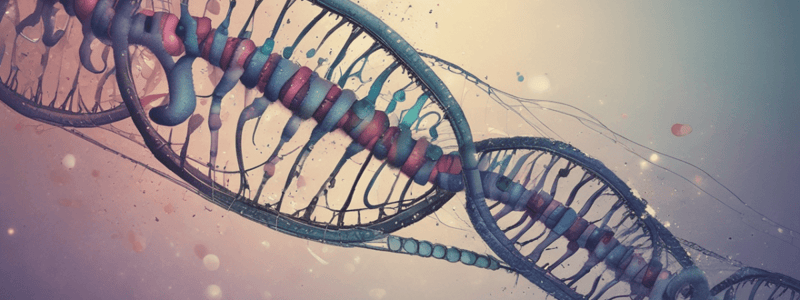Podcast
Questions and Answers
What is the result of a large deletion of genetic material?
What is the result of a large deletion of genetic material?
- Inversion of that segment of chromosome
- Monosomy for that segment of chromosome (correct)
- Duplication of that segment of chromosome
- Trisomy for that segment of chromosome
What type of deletion involves a single break of the terminal part of a chromosome?
What type of deletion involves a single break of the terminal part of a chromosome?
- Paracentric inversion
- Interstitial deletion
- Terminal deletion (correct)
- Pericentric inversion
What is the characteristic cry of a newborn with Cri-du Chat syndrome?
What is the characteristic cry of a newborn with Cri-du Chat syndrome?
- High-pitched cry
- Cat-like cry (correct)
- Hoarse cry
- Silent cry
What is the incidence of Cri-du Chat syndrome?
What is the incidence of Cri-du Chat syndrome?
What type of deletion cannot be detected by Karyotype?
What type of deletion cannot be detected by Karyotype?
What is the result of an interstitial deletion of paternal chromosome 15?
What is the result of an interstitial deletion of paternal chromosome 15?
What type of inversion involves both p and q arms with centromere?
What type of inversion involves both p and q arms with centromere?
What is the effect of duplication of a chromosome part?
What is the effect of duplication of a chromosome part?
Which of the following types of chromosomal abnormalities can result in the deletion of a short arm of chromosome 5?
Which of the following types of chromosomal abnormalities can result in the deletion of a short arm of chromosome 5?
What is the typical consequence of a large deletion of genetic material?
What is the typical consequence of a large deletion of genetic material?
Which of the following syndromes is caused by an interstitial deletion of paternal chromosome 15?
Which of the following syndromes is caused by an interstitial deletion of paternal chromosome 15?
What is the term for the process of reversing a segment of a chromosome?
What is the term for the process of reversing a segment of a chromosome?
Which of the following characteristics is NOT associated with Cri-du Chat syndrome?
Which of the following characteristics is NOT associated with Cri-du Chat syndrome?
What is the purpose of FISH technique in detecting chromosomal abnormalities?
What is the purpose of FISH technique in detecting chromosomal abnormalities?
Which of the following types of inversion involves only one arm of a chromosome?
Which of the following types of inversion involves only one arm of a chromosome?
What is the result of a terminal deletion of chromosome 5?
What is the result of a terminal deletion of chromosome 5?
Flashcards are hidden until you start studying
Study Notes
Deletion and Structural Abnormalities
- Deletion results in monosomy, usually incompatible with survival to term
- There are two types of deletions: terminal deletion and interstitial deletion
Terminal Deletion
- Involves a single break of the terminal part of a chromosome, resulting in loss of the broken part
- Example: Cri-du Chat syndrome (46,XX,5p- or 46,XY,5p-)
- Characteristics of Cri-du Chat syndrome:
- Deletion of the short arm of chromosome 5
- Incidence: 1 per 20,000 to 1 per 50,000 births
- Underdevelopment of larynx, resulting in a characteristic cat-like cry (Mewing cry)
- Mental retardation
- Microcephaly and facial anomalies
Interstitial Deletion
- Involves two breaks, resulting in loss of the intervening portion of the chromosome
- Some interstitial deletions can occur as micro-deletions, which cannot be detected by karyotype and require FISH technique for detection
- Examples: Prader-Willi syndrome (interstitial deletion of paternal chromosome 15, 15q11–q13) and Angelman syndrome (interstitial deletion of maternal chromosome 15, 15q11–q13)
Other Structural Abnormalities
- Duplication: extra copies of a chromosome part
- Inversion: involves two breaks along the chromosome, resulting in reversal of a given segment
- Pericentric inversion: inverted segment involves both p and q arms with centromere
- Paracentric inversion: inverted segment involves only one arm (p or q)
Deletion and Structural Abnormalities
- Deletion results in monosomy, usually incompatible with survival to term
- There are two types of deletions: terminal deletion and interstitial deletion
Terminal Deletion
- Involves a single break of the terminal part of a chromosome, resulting in loss of the broken part
- Example: Cri-du Chat syndrome (46,XX,5p- or 46,XY,5p-)
- Characteristics of Cri-du Chat syndrome:
- Deletion of the short arm of chromosome 5
- Incidence: 1 per 20,000 to 1 per 50,000 births
- Underdevelopment of larynx, resulting in a characteristic cat-like cry (Mewing cry)
- Mental retardation
- Microcephaly and facial anomalies
Interstitial Deletion
- Involves two breaks, resulting in loss of the intervening portion of the chromosome
- Some interstitial deletions can occur as micro-deletions, which cannot be detected by karyotype and require FISH technique for detection
- Examples: Prader-Willi syndrome (interstitial deletion of paternal chromosome 15, 15q11–q13) and Angelman syndrome (interstitial deletion of maternal chromosome 15, 15q11–q13)
Other Structural Abnormalities
- Duplication: extra copies of a chromosome part
- Inversion: involves two breaks along the chromosome, resulting in reversal of a given segment
- Pericentric inversion: inverted segment involves both p and q arms with centromere
- Paracentric inversion: inverted segment involves only one arm (p or q)
Studying That Suits You
Use AI to generate personalized quizzes and flashcards to suit your learning preferences.




